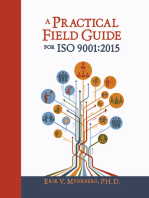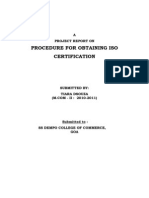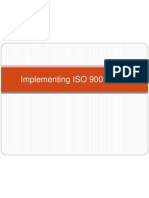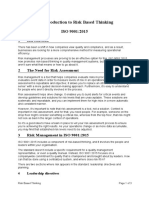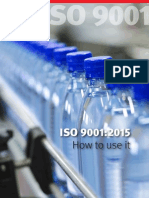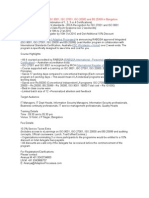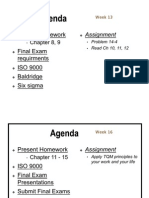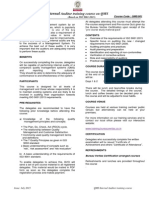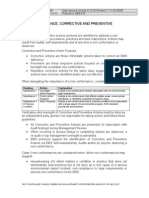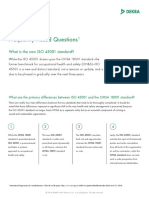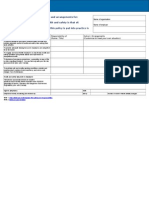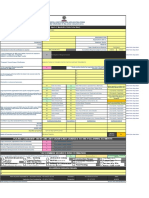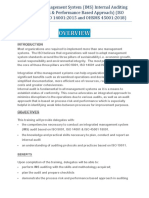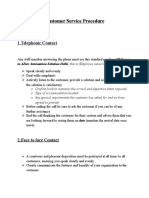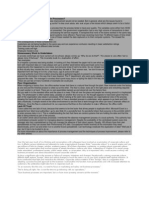Iso 9000 Steps
Iso 9000 Steps
Uploaded by
monigpCopyright:
Available Formats
Iso 9000 Steps
Iso 9000 Steps
Uploaded by
monigpOriginal Description:
Copyright
Available Formats
Share this document
Did you find this document useful?
Is this content inappropriate?
Copyright:
Available Formats
Iso 9000 Steps
Iso 9000 Steps
Uploaded by
monigpCopyright:
Available Formats
Implementing ISO 9000 Quality Management System
Implementation of ISO 9000 affects the entire organization right from the start. If pursued with total dedication, it results in 'cultural transition' to an atmosphere of continuous improvement. The process of implementing ISO 9000 depends on: The sophistication of your existing quality program, The size of your organization, and The complexity of your process. The 14 essential steps, briefly described below, are to be followed through in order to implement ISO 9000 quality management system successfully. Step 1: Top management commitment Step 2: Establish implementation team Step 3. Start ISO 9000 awareness programs Step 4: Provide Training Step 5. Conduct initial status survey Step 6: Create a documented implementation plan Step 7. Develop quality management system documentation Step 8: Document control Step 9. Implementation Step 10. Internal quality audit Step 11. Management review Step 12. Pre-assessment audit Step 13. Certification and registration Step 14: Continual Improvement
Step 1: Top Management Commitment
The top management (managing director or chief executive) should demonstrate a commitment and a determination to implement an ISO 9000 quality management system in the organization. Without top management commitment, no quality initiative can succeed. Top management must be convinced that registration and certification will enable the organization to demonstrate to its customers a visible commitment to quality. It should realize that a quality management system would improve overall business efficiency by elimination of wasteful duplication in management system. The top management should provide evidence of its commitment to the development and implementation of the quality management system and continually improve its effectiveness by: Communicating to the organization the importance of meeting customer as well as statutory and regulatory requirements, Defining the organization's quality policy and make this known to every employee, Ensuring that quality objectives are established at all levels and functions, 1
Ensuring the availability of resources required for the development and implementation of the quality management system, Appointing a management representative to coordinate quality management system activities, and Conducting management review. The top management should also consider actions such as: Leading the organization by example, Participating in improvement projects, Creating an environment that encourages the involvement of people. This type of top management commitment may be driven by: Direct marketplace pressure: requirements of crucial customers or parent conglomerates. Indirect marketplace pressure: increased quality levels and visibility among competitors. Growth ambitions: desire to exploit market opportunities. Personal belief in the value of quality as a goal and quality management systems as a means of reaching that goal. The top management should identify the goals to be achieved through the quality management system. Typical goals may be: Be more efficient and profitable Produce products and services that consistently meet customers' needs and expectations Achieve customers satisfaction Increase market share Improve communications and morale in the organization Reduce costs and liabilities Increase confidence in the production system
Step 2. Establish Implementation Team
ISO 9000 is implemented by people. The first phase of implementation calls for the commitment of top management - the CEO and perhaps a handful of other key people. The next step is to establish implementation team and appoint a Management Representative (MR) as its coordinator to plan and oversee implementation. Its members should include representatives of all functions of the organization Marketing, Design and development, Planning, Production, Quality control, etc. In the context of the standard, the MR is the person within the Organization who acts as interface between organization management and the ISO 9000 registrar. His role is, in fact, much broader than that. The MR should also act as the organizations "quality management system champion," and must be a person with:
Total backing from the CEO, Genuine and passionate commitment to quality in general and the ISO 9000 quality management system in particular, The dignity - resulting from rank, seniority, or both - to influence managers and others of all levels and functions, Detailed knowledge of quality methods in general and ISO 9000 in particular. The members of the implementation team should also be trained on ISO 9000 quality management systems by a professional training organization.
Step 3. Start ISO 9000 Awareness Programs
ISO 9000 awareness programs should be conducted to communicate to the employees the aim of the ISO 9000 quality management system; the advantage it offers to employees, customers and the organization; how it will work; and their roles and responsibilities within the system. Suppliers of materials and components should also participate in these programs. The awareness program should emphasize the benefits that the organization expects to realize through its ISO 9000 quality management system. The program should also stress the higher levels of participation and self-direction that the quality management system renders to employees. Such a focus will go far to enlist employee support and commitment. The programs could be run either by the implementation team or by experts hired to talk to different levels of employees.
Step 4. Provide Training
Since the ISO 9000 quality management system affects all the areas and all personnel in the organization, training programs should be structured for different categories of employees - senior managers, middle-level managers, supervisors and workers. The ISO 9000 implementation plan should make provision for this training. The training should cover the basic concepts of quality management systems and the standard and their overall impact on the strategic goals of the organization, the changed processes, and the likely work culture implications of the system. In addition, initial training may also be necessary on writing quality manuals, procedures and work instruction; auditing principles; techniques of laboratory management; calibration; testing procedures, etc. When in-house capacity to carry out such training is not available, it may be necessary to participate in external training courses run by professional training organizations. Alternatively, an external training institution could be invited to conduct in-house training courses.
Step 5. Conduct Initial Status Survey
ISO 9000 does not require duplication of effort or redundant system. The goal of ISO 9000 is to create a quality management system that conforms to the standard. This does not preclude incorporating, adapting, and adding onto quality programs already in place. So the next step in the implementation process is to compare the organizations existing quality management system, if there is one -- with the requirements of the standard (ISO 9001:2000). For this purpose, an organization flow chart showing how information actually flows (not what should be done) from order placement by the customer to delivery to this customer should be drawn up. From this over-all flow chart, a flow chart of activities in each department should be prepared. With the aid of the flow charts, a record of existing quality management system should be established. A significant number of written procedures may already be in place. Unless they are very much out of date, these documents should not be discarded. Rather, they should be incorporated into the new quality management system. Documents requiring modification or elaboration should be identified and listed. This exercise is some times referred to as " gap analysis''. During these review processes, wide consultation with executives and representatives of various unions and associations within the organization is required to enlist their active cooperation. In the review process, documents should be collected, studied and registered for further use, possibly after they have been revised. Before developing new quality management system documentation, you need to consider with which quality requirements or department you should start. The best is to select an area where processes are fairly well organized, running effectively and functioning satisfactorily. The basic approach is to determine and record how a process is currently carried out. We can do this by identifying the people involved and obtaining information from them during individual interviews. Unfortunately, it often happens that different people will give different, contradicting versions of a process. Each one may refer to oral instructions that are not accurate or clear. This is why the facts are often not described correctly the first time around, and have to be revised several times. Once it has been agreed how to describe the current process, this process has to be adapted, supplemented and implemented according to the requirements of the quality standard (ISO 9001:2000). This requires organizational arrangements, the drawing up of additional documents and possible removal of existing documentation (e.g. procedures, inspection/test plans, inspection/test instructions) and records (e.g. inspection/test reports, inspection/test certificates). In introducing a quality management system, the emphasis is on the improvement of the existing processes or the re-organization of processes. In general, the steps to follow are the following: Ascertain and establish the following: What is the present operation/process? What already exists? 4
Analyze the relevant sections of the quality standard - ISO 9001:2000: What is actually required? If necessary, supplement and change operational arrangements in accordance with the standard, develop documents and records, and describe operations/ processes: What is the desired operation/process? Determine and document the operation/process
How does it work?
What is required? (ISO 9001:2000)
Figure 1: Steps in introducing a quality management system The above gap analysis can be done internally, if the knowledge level is there. Or a formal pre-assessment can be obtained from any one of a large number of ISO 9000 consulting, implementing, and registration firms.
Step 6. Create a Documented Implementation Plan
Once the organization has obtained a clear picture of how its quality management system compares with the ISO 9001:2000 standard, all non-conformances must be addressed with a documented implementation plan. Usually, the plan calls for identifying and describing processes to make the organizations quality management system fully in compliance with the standard. The implementation plan should be thorough and specific, detailing: Quality documentation to be developed Objective of the system Pertinent ISO 9001:2000 section Person or team responsible Approval required Training required Resources required Estimated completion date These elements should be organized into a detailed chart, to be reviewed and approved. The plan should define the responsibilities of different departments and personnel and set target dates for the completion of activities. Once approved, the Management Representative should control, review and update the plan as the implementation process proceeds. Typical implementation action plan is shown in Figure 2. Use ISO 10005:1995 for guidance in quality planning.
Month 1
Month 3
Month 5
Month 7
Month 9
Month 11
Month 13
Appoint MR + establish implementation team ISO 9000 awareness campaign
Initial status survey + planning Develop Quality manual-Level A
Write Level B documents Write Level C documents Monitor implementation process
First internal audit
Clear nonconformities
Pre-registration audit
Quality training Compliance audit Compliance discrepancies Registration
Figure 2. Typical action plan
Step 7. Develop Quality Management System Documentation
Documentation is the most common area of non-conformance among organizations wishing to implement ISO 9000 quality management systems. As one company pointed out: "When we started our implementation, we found that documentation was inadequate. Even absent, in some areas. Take calibration. Obviously it's necessary, and obviously we do it, but it wasn't being documented. Another area was inspection and testing. We inspect and test practically every item that leaves here, but our documentation was inadequate". Documentation of the quality management system should include: Documented statements of a quality policy and quality objectives, A quality manual, Documented procedures and records required by the standard ISO 9001:2000, and Documents needed by the organization to ensure the effective planning, operation and control of its processes. Quality documentation is generally prepared in the three levels indicated in the box that follows. Use ISO 10013:1995 for guidance in quality documentation.
Level A: Quality manual States the scope of the quality management system, including exclusions and details of their justification; and describes the processes of the quality management system and their interaction. Generally gives an organization profile; presents the organizational relationships and responsibilities of persons whose work affects quality and outlines the main procedures. It may also describe organization's quality policy and quality objectives. Level B: Quality management system procedures Describes the activities of individual departments, how quality is controlled in each department and the checks that are carried out. Level C: Quality documents (forms, reports, work instructions, etc.) Work instructions describe in detail how specific tasks are performed; include drawing standards, methods of tests, customer's specifications, etc. Presents forms to be used for recording observations, etc. In small companies, the above levels of documentation could be presented in one manual; otherwise, separate manuals should be prepared.
A list of the documents to be prepared should be drawn up and the responsibility for writing the documents should be assigned to the persons concerned in various functional departments. They should be advised to prepare the drafts within a specific time frame.
Step 8: Document Control
Once the necessary quality management system documentation has been generated, a documented system must be created to control it. Control is simply a means of managing the creation, approval, distribution, revision, storage, and disposal of the various types of documentation. Document control systems should be as simple and as easy to operate as possible -- sufficient to meet ISO 9001:2000 requirements and that is all. Document control should include: Approval for adequacy by authorized person (s) before issue, Review, updating and re-approval of documents by authorized person (s), Identification of changes and of the revision status of documents, Availability of relevant versions of documents at points of use, Identification and control of documents of external origin, Assurance of legibility and identifability of documents, and Prevention of unintended use of obsolete documents. The principle of ISO 9000 document control is that employees should have access to the documentation and records needed to fulfil their responsibilities.
Step 9. Implementation
It is good practice to implement the quality management system being documented as the documentation is developed, although this may be more effective in larger firms. In smaller companies, the quality management system is often implemented all at once throughout the organization. Where phased implementation takes place, the effectiveness of the system in selected areas can be evaluated. It would be a good idea initially to evaluate areas where the chances of a positive evaluation are high, to maintain the confidence of both management and staff in the merits of implementing the quality management system. The implementation progress should be monitored to ensure that the quality management system is effective and conforms to the standard. These activities include internal quality audit, formal corrective action and management review.
Step 10. Internal Quality Audit
As the system is being installed, its effectiveness should be checked by regular internal quality audits. Internal quality audits are conducted to verify that the installed quality management system:
Conform to the planned arrangements, to the requirements of the standard (ISO 9001:2000) and to the quality management system requirements established by your organization, and Is effectively implemented and maintained. Even after the system stabilizes and starts functioning, internal audits should be planned and performed as part of an ongoing strategy. A few staff members should be trained to carry out internal auditing. Use ISO 19011 for guidance in auditing, auditor qualification and programmes.
Step 11. Management Review
When the installed quality management system has been operating for three to six months, an internal audit and management review should be conducted and corrective actions implemented. The management reviews are conducted to ensure the continuing suitability, adequacy and effectiveness of the quality management system. The review should include assessing opportunities for improvement and the need for changes to the quality management system, including the quality policy and quality objectives. The input to management review should include information on: Results of audits, Customer feed back, Process performance and product conformity, Status of preventive and corrective actions, Follow-up actions from previous management reviews, Changes that could affect the quality management system, and Recommendations for improvements. Management reviews should also address the pitfalls to effective implementation, including lack of CEO commitment, failure to involve everyone in the process, and failure to monitor progress and enforce deadlines.
Step 12. Pre-assessment Audit
When system deficiencies are no longer visible, it is normally time to apply for certification. However, before doing so, a pre-assessment audit should be arranged with an independent and qualified auditor. Sometimes certification bodies provide this service for a nominal charge. The pre-assessment audit would provide a degree of confidence for formally going ahead with an application for certification.
Step 13. Certification and Registration
Once the quality management system has been in operation for a few months and has stabilized, a formal application for certification could be made to a selected certification agency. The certification agency first carries out an audit of the documents (referred to as an "adequacy audit"). If the documents conform to the requirements of the 9
quality standard, then on-site audit is carried out. If the certification body finds the system to be working satisfactorily, it awards the organization a certificate, generally for a period of three years. During this three-year period, it will carry out periodic surveillance audits to ensure that the system is continuing to operate satisfactorily.
Step 14: Continual Improvement
Certification to ISO 9000 should not be an end. You should continually seek to improve the effectiveness and suitability of the quality management system through the use of: Quality policy Quality objectives Audit results Analysis of data Corrective and preventive actions Management review ISO 9004:2000 provides a methodology for continual improvement.
10
You might also like
- Test 1Document21 pagesTest 1SonamAgarwalNo ratings yet
- Quality System PDFDocument6 pagesQuality System PDFSavant100% (1)
- QA-2 ISO9001-2015-EnglishDocument39 pagesQA-2 ISO9001-2015-EnglishRhendi RamdhaniNo ratings yet
- IsoDocument47 pagesIsofree2dreamsNo ratings yet
- ISO 9001 2015 Bill Mizak PDFDocument35 pagesISO 9001 2015 Bill Mizak PDFblitzkrigNo ratings yet
- What Is The Role and Responsibilities of A Iso Iso 45001Document4 pagesWhat Is The Role and Responsibilities of A Iso Iso 45001Bhagat DeepakNo ratings yet
- Aqms Auditor Application User GuideDocument22 pagesAqms Auditor Application User Guidechandravel sankarakumarNo ratings yet
- Iso 9001 - 2015 ALISONDocument5 pagesIso 9001 - 2015 ALISONAymane LAKHALNo ratings yet
- Clause 8 ReqmntsDocument48 pagesClause 8 ReqmntsAkhil GuptaNo ratings yet
- Summary of Iso 90091Document3 pagesSummary of Iso 90091Ihuhwa Marta TauNo ratings yet
- Different Terminology in Iso 9001:2008 and Iso 9001:2015: I S O 9 0 0 1: 2 0 0 8 I S O 9 0 0 1: 2 0 1 5Document3 pagesDifferent Terminology in Iso 9001:2008 and Iso 9001:2015: I S O 9 0 0 1: 2 0 0 8 I S O 9 0 0 1: 2 0 1 5Mohamad YusofNo ratings yet
- Implementing ISO 9001Document11 pagesImplementing ISO 9001deb_mbmNo ratings yet
- Introduction To ISO 14001 ImplementationDocument118 pagesIntroduction To ISO 14001 ImplementationrobbiejfergussonNo ratings yet
- Iso 9001 2008 StandardDocument90 pagesIso 9001 2008 StandardArun KumarNo ratings yet
- Bosch Code of Business ConductDocument20 pagesBosch Code of Business ConductParikshit DavateNo ratings yet
- Risk Based Thinking ISO 9001-2015Document3 pagesRisk Based Thinking ISO 9001-2015AnkurNo ratings yet
- ISO 19011-2018 Terms and DefinitionsDocument4 pagesISO 19011-2018 Terms and DefinitionsredaNo ratings yet
- Environmental Aspects PDFDocument31 pagesEnvironmental Aspects PDFShyam SinghNo ratings yet
- Leaving AfghanistanDocument7 pagesLeaving AfghanistanMahdi Loman50% (2)
- How Can ISO 13485 Clause 7.4, Purchasing, Enhance ProcurementDocument3 pagesHow Can ISO 13485 Clause 7.4, Purchasing, Enhance ProcurementPavan MujawdiyaNo ratings yet
- What Is Iso CertificationDocument4 pagesWhat Is Iso CertificationShailesh GuptaNo ratings yet
- Certified ISO 14001 Lead Auditor - Four Page BrochureDocument4 pagesCertified ISO 14001 Lead Auditor - Four Page BrochurePECBCERTIFICATIONNo ratings yet
- IMS PolicyDocument1 pageIMS PolicyHamada AhmedNo ratings yet
- ISO 45001 Audit ChecklistDocument2 pagesISO 45001 Audit ChecklistMasoom QureshiNo ratings yet
- Assignment-5 03 Questions 10 Marks Each: 4.1 Audit Situation OneDocument15 pagesAssignment-5 03 Questions 10 Marks Each: 4.1 Audit Situation Onerahmanshanto623No ratings yet
- Iso 9001-2015 - How To Use ItDocument12 pagesIso 9001-2015 - How To Use Itdavid100% (1)
- KEBS ... ISO 9001-2015 Transition Guide (Secure)Document11 pagesKEBS ... ISO 9001-2015 Transition Guide (Secure)Venkatesan KattappanNo ratings yet
- Lead Auditor TrainingDocument1 pageLead Auditor Trainingrichie053No ratings yet
- ISO 9001 ChecklistDocument3 pagesISO 9001 Checklisttottenham359No ratings yet
- Quality Management Internal Auditing in Smalland Medium-Sized Companies An Exploratorystudy On Factors For Significantly Improving Qualityperformance PDFDocument22 pagesQuality Management Internal Auditing in Smalland Medium-Sized Companies An Exploratorystudy On Factors For Significantly Improving Qualityperformance PDFVjeran Furlan100% (1)
- Certification: Training Services - 2018 - QatarDocument12 pagesCertification: Training Services - 2018 - QatarSoe LwinNo ratings yet
- Iso 90000Document19 pagesIso 90000Senthil MuruganNo ratings yet
- Course Registration Form - CQI-IRCA Certified ISO 9001-2015 QMS Lead AuditorDocument1 pageCourse Registration Form - CQI-IRCA Certified ISO 9001-2015 QMS Lead AuditorAasim IftikharNo ratings yet
- Presentation Project Proposal For ISO14001 Implementation 14001academy enDocument11 pagesPresentation Project Proposal For ISO14001 Implementation 14001academy enTomas MoralesNo ratings yet
- Brochure ISO 14001Document6 pagesBrochure ISO 14001Mario Marcus HyppolitoNo ratings yet
- Requirement For Iso 9001 2015Document3 pagesRequirement For Iso 9001 2015Anonymous r2EiqSrBNo ratings yet
- ISO 9001 2015 DraftDocument37 pagesISO 9001 2015 DraftDipakNo ratings yet
- QMS 001 QMS Internal Auditor 5Document2 pagesQMS 001 QMS Internal Auditor 5Yuvan Karthik Mech100% (1)
- Internal Quality Audit For ISO 9001 2008Document115 pagesInternal Quality Audit For ISO 9001 2008Srinivasan RadhaNo ratings yet
- 014.01 Non-Conformance Corrective and Prev Action 2Document3 pages014.01 Non-Conformance Corrective and Prev Action 2LoveNo ratings yet
- Revision ISODocument3 pagesRevision ISOKannan JaganNo ratings yet
- Health and Safety Policy: (Name / Title) (Customise To Meet Your Own Situation)Document3 pagesHealth and Safety Policy: (Name / Title) (Customise To Meet Your Own Situation)Mohammed YousufNo ratings yet
- Audit Non Conformance ReportDocument4 pagesAudit Non Conformance Reportbudi_alamsyah100% (2)
- Bureau Veritas Certification Application FormDocument4 pagesBureau Veritas Certification Application FormDEVIKA PHULENo ratings yet
- ISO 9001:2015 Documentation ToolkitDocument2 pagesISO 9001:2015 Documentation ToolkitGaurav KansaraNo ratings yet
- Integrated Management System (IMS) Internal Auditing (Process Risk & Performance Based Approach) (ISO 9001:2015, ISO 14001:2015 and OHSMS 45001:2018)Document4 pagesIntegrated Management System (IMS) Internal Auditing (Process Risk & Performance Based Approach) (ISO 9001:2015, ISO 14001:2015 and OHSMS 45001:2018)AnkurNo ratings yet
- Manager of Quality/Organizational Excellence CertificationDocument6 pagesManager of Quality/Organizational Excellence CertificationkalslingamNo ratings yet
- Certified ISO 9001 Lead Implementer - Two Page BrochureDocument2 pagesCertified ISO 9001 Lead Implementer - Two Page BrochurePECBCERTIFICATIONNo ratings yet
- 5952 Frequently Asked Questions 9001 2015Document4 pages5952 Frequently Asked Questions 9001 2015ramanadkNo ratings yet
- Understanding of ISO9000 StandardsDocument36 pagesUnderstanding of ISO9000 StandardsLove100% (1)
- Iso 14001 Ems Ohsas 18001 Auditing Training Courses Programmes in Malaysia PDFDocument5 pagesIso 14001 Ems Ohsas 18001 Auditing Training Courses Programmes in Malaysia PDFMuhamad Firdaus100% (1)
- ISO 9000 - Quality ManagementDocument9 pagesISO 9000 - Quality ManagementVictor DharNo ratings yet
- Customer Service ProcedureDocument3 pagesCustomer Service ProcedureRahmat Siddique100% (1)
- ISO 9000 A Stepping Stone To Total Quality ManagementDocument9 pagesISO 9000 A Stepping Stone To Total Quality ManagementMarcus Skookumchuck VanniniNo ratings yet
- Bsi - Iso 9001 CoursesDocument2 pagesBsi - Iso 9001 CoursesEsu PasalaNo ratings yet
- Exploring Talent Management in IndiaDocument16 pagesExploring Talent Management in IndiamonigpNo ratings yet
- Intrinsic RewardDocument6 pagesIntrinsic RewardmonigpNo ratings yet
- TQM ProjectsDocument8 pagesTQM ProjectsmonigpNo ratings yet
- Product Design and Development Lec-1Document28 pagesProduct Design and Development Lec-1monigpNo ratings yet
- What Are The Problems Found in ProcessesDocument3 pagesWhat Are The Problems Found in ProcessesmonigpNo ratings yet
- DmadvDocument4 pagesDmadvmonigpNo ratings yet

